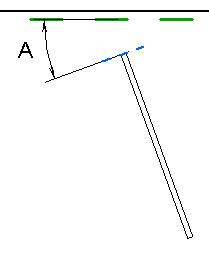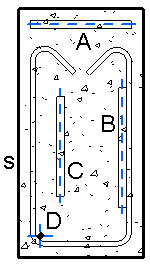Rebar constraints set and lock the geometry of each rebar instance with respect to its concrete host element.
Rebar elements are unique in the following ways:
- Composed of completely flexible geometry
- Subject to the definition of its rebar shape
- Dimensions and position are determined entirely by other elements.
Hosted elements such as windows in walls have some of their geometry set by their hosts, and may move with their hosts, they also have pre-determined, fixed dimensions due to their family and/or type. A locked dimension is required to lock the location of the window with respect to a certain edge of its host wall.
However, rebar flexes to arbitrary dimensions. Its position and geometry automatically set by considering the geometry of its host, as well as the presence of other rebar. Once the geometry is set, assigned constraints move and flex in response to changes in the model.
Types of Rebar Constraints
Rebar constraints lock rebar handle planes to planar references as follows:
- Concrete element surfaces
- Stirrup bar handle planes. (standard style bars only)

You can specify the following types of constraints:
- Rebar Cover
- Other Rebar (Stirrup Handle Plane)
- To Host Surface
- Bar A: Constrains to the rebar cover at the top surface of the beam.
- Bar B. Constrains to stirrup of other rebar.
- Bar C. Constrains to the nearest parallel host surface (S).
- Bar D. A special constraint case. Longitudinal straight bar placed near a bend in the stirrup can constrain themselves to distinct locations along bends in stirrup bars. For example the points at 45 degree increments around each bend such as 0°, 45°, 90°, 135° and so on. An offset is applied to the constraints to rest the longitudinal bar against the inside of the stirrup's bend at the desired angular position.

Default Logic for Selecting Constraints References
The default constraint logic sequence for placed rebar is as follows:
- (Straight bars only) The bar seeks stirrup bar bend reference points to constrain its edge and planar position handles.
- The bar seeks the nearest host element cover surface. Standard style bars also look for stirrup bar handles, ignoring any host cover already occupied by a stirrup.
- If no cover surface or stirrup is found within the required tolerance, the bar seeks the nearest host surface, with or without cover. A constant distance lock constraint to that surface is formed.
Related Topics